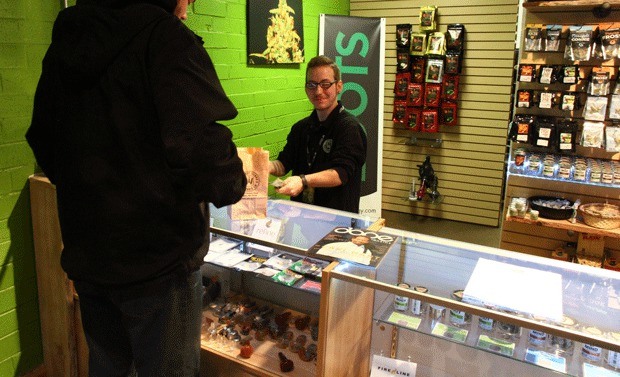“Have you tried the Pink Lady Kush concentrate? It’s an 80/20 indica dominant.”
So went clerk Aeron Nyx’s sales pitch to a customer recently at Bayview’s Whidbey Island Cannabis Co. It was obscure to the non-smoker. But the customer, who asked to be identified only as Kelvin, happily walked away with about $60 worth of product.
“Buying at stores is new to a lot of us,” said Kelvin, 29, who said he has smoked marijuana for about three years. “The staff here gives accurate information that helps me narrow down what I like.”
Whidbey Island Cannabis, co-owned by Mo’s Pub owner Maureen Cooke, was the island’s first recreational-pot retailer, open for business Oct. 24, 2014. Manager Carly Houghton has worked there since the beginning.
“That day was pretty crazy,” Houghton said. “We had customers lined up out the door to pay $30 per gram, which was outrageous.”
Since then, retail prices have tumbled to $9-$16 per gram — at the lower end, roughly equal to street prices on a per-gram basis, though still more expensive than if pot is bought from a street dealer in larger quantities.
Legalization has meant more customers for illegal street dealers, but the advent of licensed retailers has also hurt them.
“If you come here, you know exactly what you’re getting,” she said. “You know it’s tested and is high quality. People really like that.”
When the store opened for business, inventory was sparse. Now a long line of gleaming glass cases and wall displays showcase hundreds of items. Among them are glass pipes, refillable and disposable vape pens, ultra-pure marijuana wax and oil, pre-rolled joints, capsules and marijuana-infused cookies, brownies, chocolates, caramels, hard candies, lemonade, mints and tea.
And, of course, marijuana. Not the crumpled baggies full of sticks, stems, seeds and leaves some may remember from high school days. Just a few fragrant, crystalline flowers carefully sealed in small, handsomely designed packets. The store sells about 23 strains. It has carried up to 32 at a time, but customers got overwhelmed. The indica species of cannabis tends to induce body sensations and produce a drowsy high, Houghton said.
The sativa species produces a more active, focused high.
THC is the main psychoactive ingredient in pot. The flowers’ THC content averages 23 percent, though many customers prefer buds in the higher 20s, she said.
“Wax” — marijuana commonly purified using butane — can be 60-80 percent THC. That’s dangerously high for all but the most experienced users. Each packet of flowers by law displays the content of THC, cannabidiol and other active ingredients. Cannabidiol has been shown to offer medical benefits.
Though state-required testing provides a scientific basis for choosing which bud to burn, marketing too plays a role. Pick up a menu at the counter. Who could resist names like Train Wreck, White Widow, Purple Alien, The Hog and Ewok? These days, the top seller is Gorilla Glue, a hybrid indica-sativa strain that’s “really heavy hitting,” Houghton said.
The taste and smell of each strain varies, and indicas clearly produce different effects than sativas, but beyond that, growers, retailers and customers agreed there is no consistent difference in the effects different strains produce.
October gross sales at Whidbey Island Cannabis were $113,490, and gross sales to date were $697,400, according to data found on website 502data.com and confirmed by Houghton. She declined to provide net numbers, saying only that the business is profitable.
“People think it makes millions and millions of dollars, but we’re not making as much as one might guess,” she said. “We try to keep the prices as low as possible so people don’t feel they’re getting ripped off.”
Federal-income-tax laws on marijuana are in a state of flux, Cooke said. So “we won’t know until after the year ends whether we’re totally profitable or only marginal.”
A state law enacted this summer eliminated excise taxes for growers and processors and boosted the rate for retailers to 37 percent from 27 percent of sales. Most growers immediately cut their prices, allowing retailers to hold theirs steady, Houghton said. But the higher tax is cutting into margins, “almost to the point it’s unprofitable,” Houghton said.
Balancing supply and demand has been one of the state’s objectives since I-502 legalized recreational pot. At the moment, supply exceeds demand, to the extent that “we’re kind of overwhelmed by how many want to sell their product here,” Houghton said.
About 120 customers come in each day, each spending roughly $20-$50. Sales are brisk Fridays and Saturdays and fall off Sundays through Tuesdays.
Like most growers, processors and retailers, the store operates as an all-cash business, because few banks accept marijuana-related money. Pot is still a federally controlled substance, so banks fear government interference and the loss of their FDIC insurance. That’s why the store uses Salal Credit Union — one of the few financial institutions that does accept marijuana money — and submits deposits by armored car.
With both cash and valuable product on hand, every participant in the marijuana business has feared becoming a robbery target. Whidbey Island Cannabis has 15 security cameras recording 24/7, frosted and barred windows and a panic button. A few sketchy visitors and suspicious cars have prompted calls to the Langley Police, who arrived swiftly, but that’s been the extent of the problem, Houghton said.
One challenge for the store has been keeping current with state regulations, which change often, she said. This fall it was fined or written up five times for violations, including an employee’s failure to wear an ID badge and shortcomings in its surveillance and product-tracking systems, according to records maintained by the Washington State Liquor and Cannabis Control Board.
Like Kelvin, several other of the store’s customers declined to be photographed or identified by name.
“They don’t want their image as a stoner to be out in public,” said Nyx, the clerk.
“For a lot of people, there’s still a stigma to smoking pot.”



